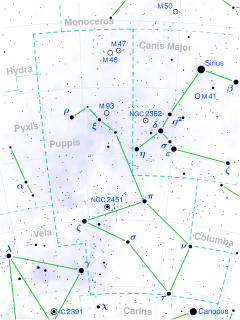
Tau Tauri, Latinized from τ Tauri, is a quadruple star system in the constellation Taurus. It is visible to the naked eye as a faint point of light with a combined apparent visual magnitude of 4.33. The distance to this system is approximately about 400 light years based on parallax. The system is moving further from the Earth with a heliocentric radial velocity of +14.6 km/s, and it is a member of the Taurion OB association, located between Orion and Taurus. It is located 0.7 degree north of the ecliptic, and thus is subject to lunar occultations.

ν Persei, Latinized as Nu Persei, is a single star and a suspected variable in the northern constellation of Perseus. It has a yellow-white hue and is visible to the naked eye with an apparent visual magnitude of 3.80. This object is located approximately 560 light-years from the Sun based on parallax but is drifting closer with a radial velocity of −12 km/s.

67 Ophiuchi is a class B5 Ib star in the constellation Ophiuchus. Its apparent magnitude is 3.93 and it is approximately 1200 light years away based on parallax. It is considered to be a member of the open cluster Collinder 359.
Zeta Monocerotis, Latinized from ζ Monocerotis, is a single, yellow-hued star in the constellation Monoceros. It has an apparent visual magnitude of 4.33, which is bright enough to be visible to the naked eye. The annual parallax shift as measured during the Hipparcos mission is 3.08 milliarcseconds, which provides a rough distance estimate of 1,060 light years. It is moving away from the Sun with a radial velocity of +30 km/s.

19 Monocerotis is a single, variable star in the equatorial constellation of Monoceros, located approximately 1,220 light years away from the Sun based on parallax. It has the variable star designation V637 Monocerotis, while 19 Monocerotis is the Flamsteed designation. This object is visible to the naked eye as a faint, blue-white hued star with a baseline apparent visual magnitude of 5.00. It is receding from the Earth with a heliocentric radial velocity of +25 km/s.

66 Ophiuchi is a binary variable star in the equatorial constellation of Ophiuchus. It has the variable star designation V2048 Ophiuchi, while 66 Ophiuchi is the Flamsteed designation. This object is visible to the naked eye as a faint, blue-white hued point of light with a baseline apparent visual magnitude of 4.60. It is located approximately 650 light years away from the Sun based on parallax, but is drifting closer with a radial velocity of −13 km/s. The star has a peculiar velocity of 13.1±3.2 km/s relative to its neighbors.

42 Orionis is a class B1V star in the constellation Orion. Its apparent magnitude is 4.59 and it is approximately 900 light years away based on parallax.

22 Orionis is a binary star in the equatorial constellation of Orion. It has the Bayer designation o Orionis, while 22 Orionis is the Flamsteed designation. This system is visible to the naked eye as a faint, blue-white hued star with an apparent visual magnitude of 4.74. It is located approximately 1,100 light years away from the Sun based on parallax. The system is moving further from the Earth with a heliocentric radial velocity of +28.80

4 Persei is a single star in the northern constellation of Perseus, located around 670 light years away from the Sun. It is visible to the naked eye as a faint, blue-white hued star with an apparent visual magnitude of 5.04 The Bayer designation for this star is g Persei; 4 Persei is the Flamsteed designation. This object has a peculiar velocity of 26.3 km/s and may be a runaway star.

HD 63922 is a class B0III star in the constellation Puppis. Its apparent magnitude is 4.11 and it is approximately 1600 light years away based on parallax.

HD 64760 is a class B0.5 supergiant star in the constellation Puppis. Its apparent magnitude is 4.24 and it is approximately 1,660 light years away based on parallax.

HD 65810 is a class A2V star in the constellation Puppis. Its apparent magnitude is 4.61 and it is approximately 241 light years away based on parallax.

NV Puppis, also known as υ1 Puppis, is a class B2V star in the constellation Puppis. Its apparent magnitude is 4.67 and it is approximately 800 light years away based on parallax.

HD 59890 is a class G3Ib star in the constellation Puppis. Its apparent magnitude is 4.65 and it is approximately 1500 light years away based on parallax.

HD 63744 is a class K0III star in the constellation Puppis. Its apparent magnitude is 4.71 and it is approximately 232 light years away based on parallax.

HD 68601 is a class A7Ib star in the constellation Puppis. Its apparent magnitude is 4.75 and it is approximately 4,200 light years away based on parallax.

HD 70555 is a class K2.5II-III star in the constellation Puppis. Its apparent magnitude is 4.83 and it is approximately 1,010 light years away based on parallax.

HD 61831 is a class B2.5V star in the constellation Puppis. Its apparent magnitude is 4.84 and it is approximately 556 light years away based on parallax.

HD 167818 is a class K3II star in the constellation Sagittarius. Its apparent magnitude is 4.66 and it is approximately 760 light years away based on parallax.

HD 172910 is a class B2.5V star in the constellation Sagittarius. Its apparent magnitude is 4.87 and it is approximately 467 light years away based on parallax.







